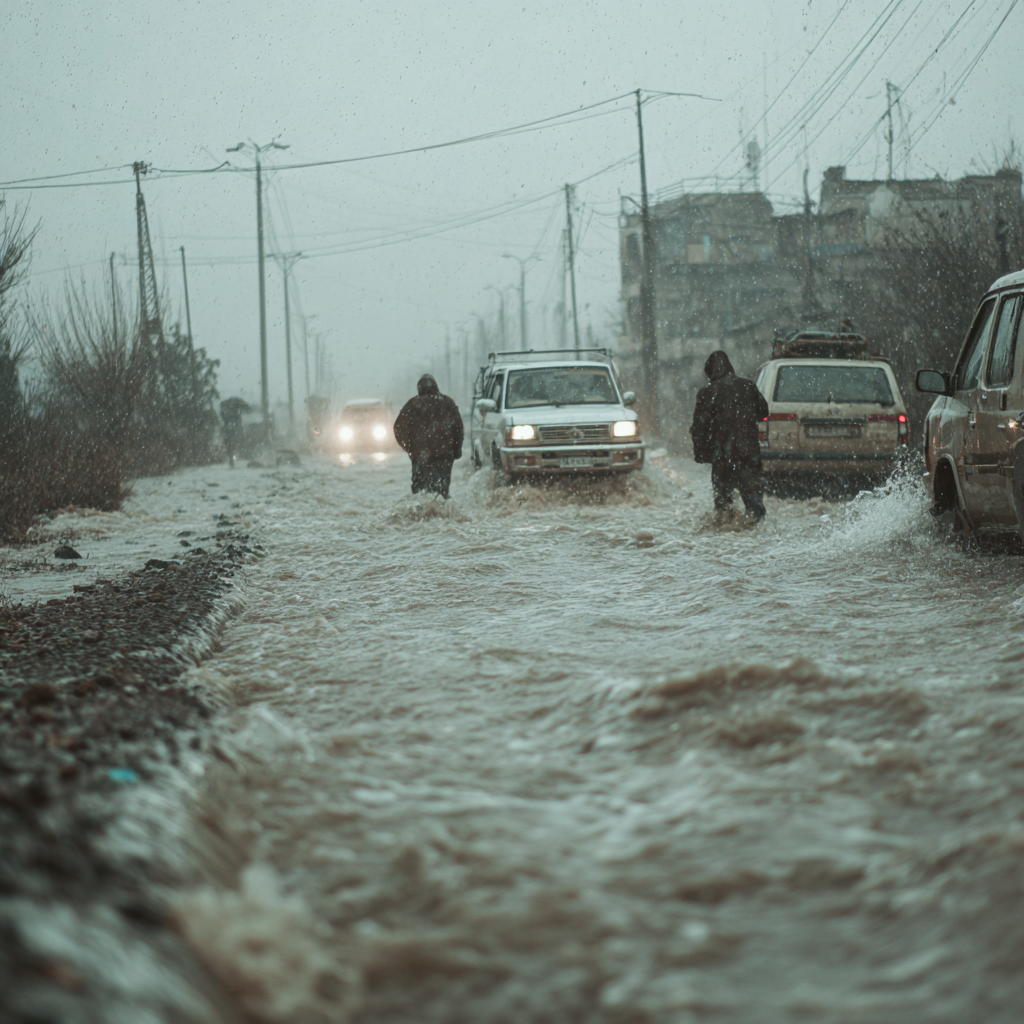The Earth is barreling toward an irreversible transformation. Atmospheric carbon dioxide, largely driven by human fossil fuel combustion, has surged past 424 parts per million—the highest level in over three million years. If emissions continue at the present rate of roughly 40 billion metric tons annually, the world faces a chain reaction of climate-driven disasters that could result in systemic global catastrophe within this century. While some cling to optimism, the emerging scientific consensus is unequivocal: absent rapid, coordinated change, we are approaching a future defined not by adaptation, but by breakdown.
The False Comfort of Gradualism
It is a common misconception that climate change will unfold as a slow, manageable process. But the truth is more treacherous. Climate systems do not respond linearly—they respond chaotically. What appears to be a stable plateau of warming can, beyond certain thresholds, trigger feedback loops and tipping points that dramatically accelerate planetary disruption. These include the loss of polar ice sheets, Amazon rainforest dieback, thawing permafrost that releases methane, and the potential weakening or collapse of the Atlantic Meridional Overturning Circulation (AMOC)—a vital component of global ocean currents. Each of these events is a destabilizing force. Together, they form a cascading network of systemic risk.
Ecological Collapse Has Already Begun
Ecosystems are the invisible scaffolding of civilization. They regulate air and water quality, stabilize the climate, support agriculture, and provide the biodiversity on which we all depend. But they are collapsing. Coral reefs, which support the food chains of over 500 million people, are dying off en masse as ocean temperatures rise and acidification increases. At just 1.5°C of warming—a threshold we are likely to breach within a decade—90% of coral reefs are expected to disappear. At 2°C, they are functionally extinct. The Amazon, often called the lungs of the planet, faces a tipping point between 2–3°C of warming where deforestation and drought become self-reinforcing, turning the rainforest into a dry savannah. Permafrost regions in the Arctic, already melting, threaten to release gigatons of methane—an even more potent greenhouse gas than CO₂—into the atmosphere, further heating the planet in a vicious feedback loop.
A World of Hunger and Thirst
As the planet warms, the most immediate human cost will be borne through food and water insecurity. Climate models consistently show that global crop yields decline with every degree of warming. Wheat, maize, rice—cornerstones of global nutrition—are highly sensitive to temperature extremes and changing precipitation patterns. What begins as a reduction in yield soon becomes a supply shock. By mid-century, hundreds of millions may face food scarcity in regions from sub-Saharan Africa to Southeast Asia, compounded by volatile global markets and hoarding by wealthier nations. Freshwater availability, already strained by overuse and pollution, will decline as glacier-fed rivers dry up and prolonged droughts become the norm. Some models estimate that 1.5 billion people could face severe water stress within the next few decades. This is not a distant theoretical future—it is the logical result of continuing on our current path.
Zones of Death and Displacement
If emissions continue unchecked, some regions will become literally uninhabitable. In areas of the Middle East, North Africa, South Asia, and the U.S. Southwest, extreme heat and humidity are projected to reach what are known as “wet-bulb” temperatures—levels at which the human body can no longer cool itself through sweating. Sustained exposure to such conditions leads to death in a matter of hours, even in the shade. Already, these events have occurred briefly in places like Pakistan and the Persian Gulf. Under a +3°C world, they become commonplace. This will result in mass displacement—hundreds of millions of people forced to leave their homes not by war or economics, but by atmospheric physics. No wall can stop this kind of migration, and no economy can remain stable amid such vast demographic upheaval.
The Collapse of Order
Climate change is not just a physical or environmental threat—it is a political one. As resources dwindle and disasters multiply, fragile states will fall first. Failed harvests and floods lead to inflation, unrest, and the breakdown of governance. Civil wars and insurgencies, particularly in regions already destabilized by economic inequality or sectarian divisions, will flare. The wealthy will retreat into enclaves, protected by private security and surrounded by failing infrastructure. Insurance companies are already abandoning markets like Florida and California, deeming them too risky. Entire economies, particularly those dependent on agriculture or coastal real estate, may become uninsurable—and therefore, uninvestable. This is the beginning of de-civilization: a slow but accelerating retreat from the assumptions of modernity—predictable seasons, reliable energy, habitable cities.
No Rescue from Ice or Clouds
Some argue that melting polar ice could slow or offset warming through localized “cooling” effects. It’s true that the melting of Greenland and Antarctic ice sheets is dumping vast amounts of cold freshwater into the oceans, creating regions of regional cooling (e.g., the North Atlantic “cold blob”). But this is not a climate benefit—it is a symptom of catastrophic change. Slowing the AMOC may cool parts of Europe or suppress Atlantic hurricanes temporarily, but at the expense of worsening droughts in Africa, heatwaves in the U.S., and monsoon failure in India. It is not global cooling—it is regional destabilization. Likewise, geoengineering ideas like stratospheric aerosol injection or marine cloud brightening remain unproven, politically fraught, and risky. They are not a substitute for emissions reduction.
The Probability of Collapse
If emissions continue at their current pace, the Earth is projected to warm by 2.5–3.0°C by 2100. This is not speculative. It is the trajectory baked into nearly all models absent transformative global action. At these levels of warming, the risk of systemic failure—defined as the breakdown of food systems, ecological networks, governance structures, and human habitability—rises dramatically. While the probability of absolute global civilizational collapse is debated, the likelihood of large-scale regional collapses, mass mortality, and ungovernable zones is high. At +3°C, the world will experience conditions that are not just unfamiliar—but incompatible with current forms of human life.
What Must Be Done
There is no mystery about the solution. Emissions must fall by roughly 50% by 2030 to remain within a 1.5–2.0°C pathway. This requires phasing out fossil fuel subsidies, accelerating investment in renewable energy, transforming food and transport systems, and developing robust adaptation plans. The cost of doing so is high—but the cost of inaction is incalculably greater. Every fraction of a degree matters. Every year of delay locks in suffering that cannot be undone.
What About Me?
It is reasonable—human, even—to feel overwhelmed. The scale of the crisis, the inertia of governments, the power of fossil fuel industries, the slow pace of reform—all of it can breed paralysis. But the question that echoes most urgently for many of us is simple: What can I do? What can one individual possibly do in the face of such a vast, systemic threat?
The answer is not about purity. No one in the modern world has zero carbon impact—not the vegan bicyclist, not the off-grid homesteader, not the eco-conscious app user. Our society is built on fossil fuels: in the food we eat, the energy we consume, the devices we use, the buildings we inhabit. But there is still power—real, measurable power—in personal action. Especially when it is conscious, sustained, and shared.
The most direct way to reduce your footprint is to cut fossil fuel consumption wherever you can. This means choosing renewable electricity if available, driving less or switching to public transport, biking, or EVs, and improving energy efficiency in your home. Insulate. Use heat pumps. Turn down the thermostat. Upgrade appliances. Avoid unnecessary flights—air travel is one of the largest per-capita emitters. If you must fly, fly direct, and consider offsetting with certified reforestation or carbon removal programs—but only as a last resort, not a license to pollute.
Diet matters, too. Industrial meat and dairy production is a major driver of emissions and land degradation. Shifting toward a plant-based diet—or simply reducing red meat consumption—has a disproportionate effect on lowering your personal footprint. The same goes for waste reduction: eating what you buy, composting organic matter, and minimizing packaging waste all help disrupt the extractive consumer cycle.
What you buy—and don’t buy—also matters. Every smartphone, every fast-fashion shirt, every impulse Amazon package carries a carbon cost. The mantra “reduce, reuse, recycle” still applies, but with modern urgency: reduce consumption wherever possible; reuse with intention (repairs, swaps, second-hand goods); and recycle only what cannot be avoided.
But the most powerful action you can take is collective. Vote with your wallet, yes—but also vote at the ballot box. Pressure your city, your employer, your school, your local utility. Join or fund climate organizations. Support legal actions against polluters. Talk to others. Break the silence. Systemic change will not happen without mass demand.
You are not powerless. You are not irrelevant. Your choices, while not sufficient on their own, are not meaningless. In fact, they are part of the only force capable of turning the tide: a population that sees clearly, acts boldly, and refuses to accept collapse as destiny.
We built this world. We can unbuild what must be unbuilt—and begin again. But only if we stop waiting for someone else to go first.
Final Words
We are not witnessing the slow evolution of climate—we are witnessing a global emergency unfold in real time. The ice is melting, the forests are burning, and the sky itself is turning hostile. This is not the distant future. It is our present. And unless we act now—boldly, collectively, and immediately—what follows will not be history as usual, but a rupture in the human story. The catastrophe is not hypothetical. It is coming. The only question left is how much worse we are willing to let it get.
om tat sat


Member discussion: